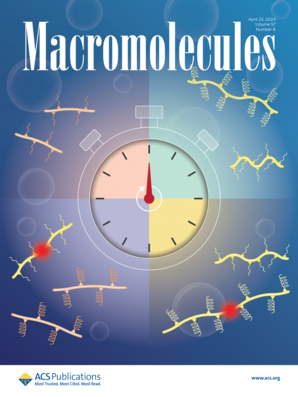离散丁内酯-己内酯共聚物的结晶和熔融行为:端基的影响
IF 5.1
1区 化学
Q1 POLYMER SCIENCE
引用次数: 0
摘要
由于分子量分布和分子结构的精度对聚合物的结晶行为起着至关重要的作用,离散低聚物是研究聚合物结晶行为的理想候选者。以ε-己内酯(ε-CL)和γ-丁内酯(γ-BL)为单体,采用迭代指数增长(IEG)方法,精确合成具有不同端基的离散选择性共聚物(o(γ-BL-alt-ε-CL)s),并以精确的单体序列系统地研究了o(γ-BL-alt-ε-CL)s的结晶和熔融行为。强调了端基在共低聚物结晶和熔融过程中所起的作用。具有不同端基(叔丁基二苯基硅基、苯甲酰、乙酰基)的o(γ-BL-alt-ε-CL)s结晶为延伸链构象。观察到随着端基的增大,共低聚物的结晶速率降低,这与大端基下共低聚物链的慢动力学或慢弛豫有关。端基小的o(γ-BL-alt-ε-CL)s在加热过程中的熔融再结晶主要归因于位阻效应的降低。对于端基较大的o(γ-BL-alt-ε-CL)s,位阻效应极大地阻碍了共低聚物链的重排,从而显著抑制了熔融再结晶。本文章由计算机程序翻译,如有差异,请以英文原文为准。

Crystallization and Melting Behaviors of Discrete Butyolactone–Caprolactone Alternative Co-Oligomer: The Effect of End Groups
Discrete oligomers are ideal candidates for the investigation of the crystallization behaviors of polymers since the molecular weight distribution and the precision of molecular structures play a crucial role in the crystallization behaviors of polymers. We precisely synthesize discrete alternative co-oligomers (o(γ-BL-alt-ε-CL)s) with different end groups based on ε-caprolactone (ε-CL) and γ-butyrolactone (γ-BL) as monomers using an iterative exponential growth (IEG) strategy and systematically study the crystallization and melting behaviors of the o(γ-BL-alt-ε-CL)s with precise monomer sequence. The roles that the end group plays in the crystallization and melting of co-oligomers are highlighted. The o(γ-BL-alt-ε-CL)s with different end groups (tert-butyldiphenylsilyl, benzoyl, acetyl) crystallize in an extended-chain conformation. Observation on the decrease of the crystallization rate of co-oligomers with the increase of the size of the end groups is associated with the slow dynamics or slow relaxation of co-oligomer chains with the large end group. The melting–recrystallization during the heating process for the o(γ-BL-alt-ε-CL)s with small end group is attributed primarily to the reduced steric hindrance effect. For the o(γ-BL-alt-ε-CL)s with large end groups, the rearrangement of co-oligomer chains is substantially hindered by steric effects, which lead to a significant suppression of the melting–recrystallization.
求助全文
通过发布文献求助,成功后即可免费获取论文全文。
去求助
来源期刊

Macromolecules
工程技术-高分子科学
CiteScore
9.30
自引率
16.40%
发文量
942
审稿时长
2 months
期刊介绍:
Macromolecules publishes original, fundamental, and impactful research on all aspects of polymer science. Topics of interest include synthesis (e.g., controlled polymerizations, polymerization catalysis, post polymerization modification, new monomer structures and polymer architectures, and polymerization mechanisms/kinetics analysis); phase behavior, thermodynamics, dynamic, and ordering/disordering phenomena (e.g., self-assembly, gelation, crystallization, solution/melt/solid-state characteristics); structure and properties (e.g., mechanical and rheological properties, surface/interfacial characteristics, electronic and transport properties); new state of the art characterization (e.g., spectroscopy, scattering, microscopy, rheology), simulation (e.g., Monte Carlo, molecular dynamics, multi-scale/coarse-grained modeling), and theoretical methods. Renewable/sustainable polymers, polymer networks, responsive polymers, electro-, magneto- and opto-active macromolecules, inorganic polymers, charge-transporting polymers (ion-containing, semiconducting, and conducting), nanostructured polymers, and polymer composites are also of interest. Typical papers published in Macromolecules showcase important and innovative concepts, experimental methods/observations, and theoretical/computational approaches that demonstrate a fundamental advance in the understanding of polymers.
 求助内容:
求助内容: 应助结果提醒方式:
应助结果提醒方式:


